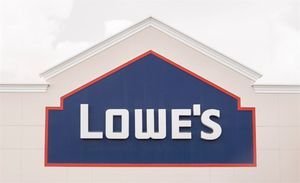
Automotive manufacturer Ford (NYSE: F) reported Q1 CY2025 results exceeding the market’s revenue expectations, but sales fell by 5% year on year to $40.66 billion. Its non-GAAP profit of $0.14 per share was significantly above analysts’ consensus estimates.
Is now the time to buy Ford? Find out by accessing our full research report, it’s free.
Ford (F) Q1 CY2025 Highlights:
- Revenue: $40.66 billion vs analyst estimates of $38.49 billion (5% year-on-year decline, 5.6% beat)
- Adjusted EPS: $0.14 vs analyst estimates of $0.02 (significant beat)
- Tariffs: "the company estimates a net adverse adjusted EBIT impact of about $1.5 billion for full-year 2025"
- Suspension of financial guidance: "These are substantial industry risks, which could have significant impacts on financial results, and that make updating full year guidance challenging right now given the potential range of outcomes"
- Operating Margin: 0.8%, down from 2.9% in the same quarter last year
- Free Cash Flow was $1.86 billion, up from -$709 million in the same quarter last year
- Sales Volumes fell 7.1% year on year (-0.9% in the same quarter last year)
- Market Capitalization: $40.88 billion
Company Overview
Established to make automobiles accessible to a broader segment of the population, Ford (NYSE: F) designs, manufactures, and sells a variety of automobiles, trucks, and electric vehicles.
Sales Growth
Reviewing a company’s long-term sales performance reveals insights into its quality. Any business can put up a good quarter or two, but many enduring ones grow for years. Over the last five years, Ford grew its sales at a sluggish 4.1% compounded annual growth rate. This fell short of our benchmark for the industrials sector and is a rough starting point for our analysis.
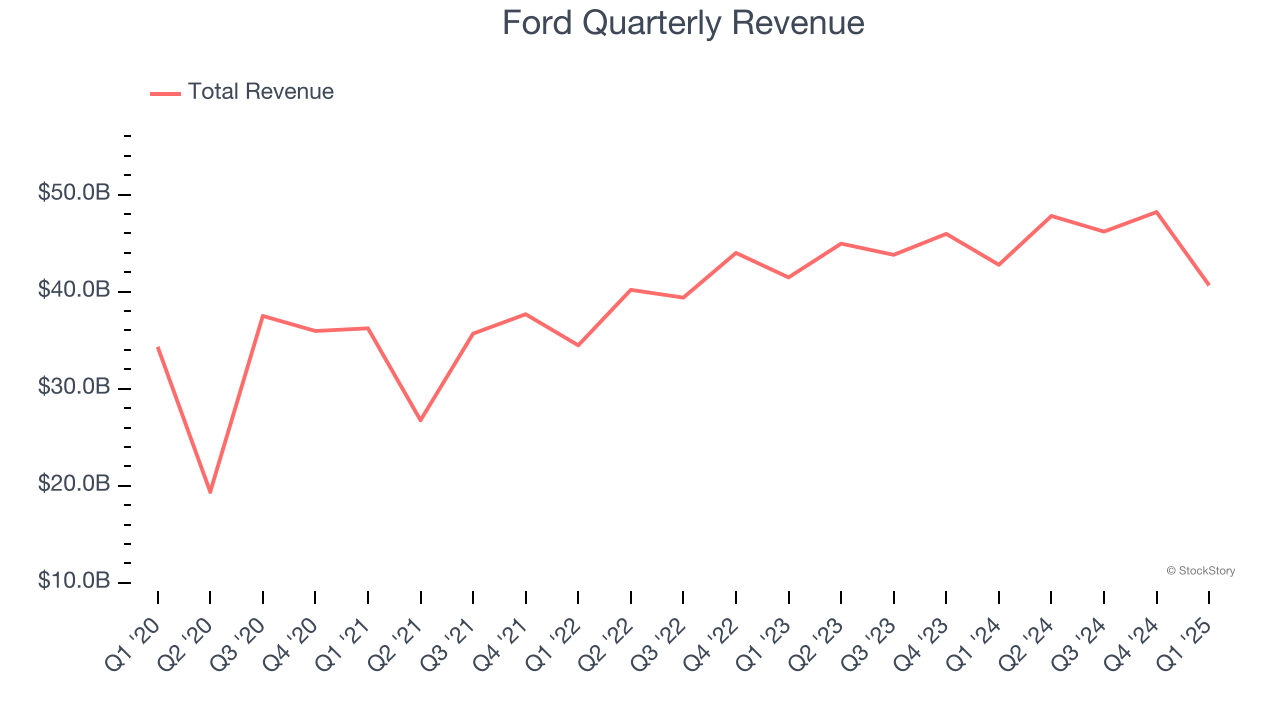
We at StockStory place the most emphasis on long-term growth, but within industrials, a half-decade historical view may miss cycles, industry trends, or a company capitalizing on catalysts such as a new contract win or a successful product line. Ford’s annualized revenue growth of 5.3% over the last two years is above its five-year trend, but we were still disappointed by the results. 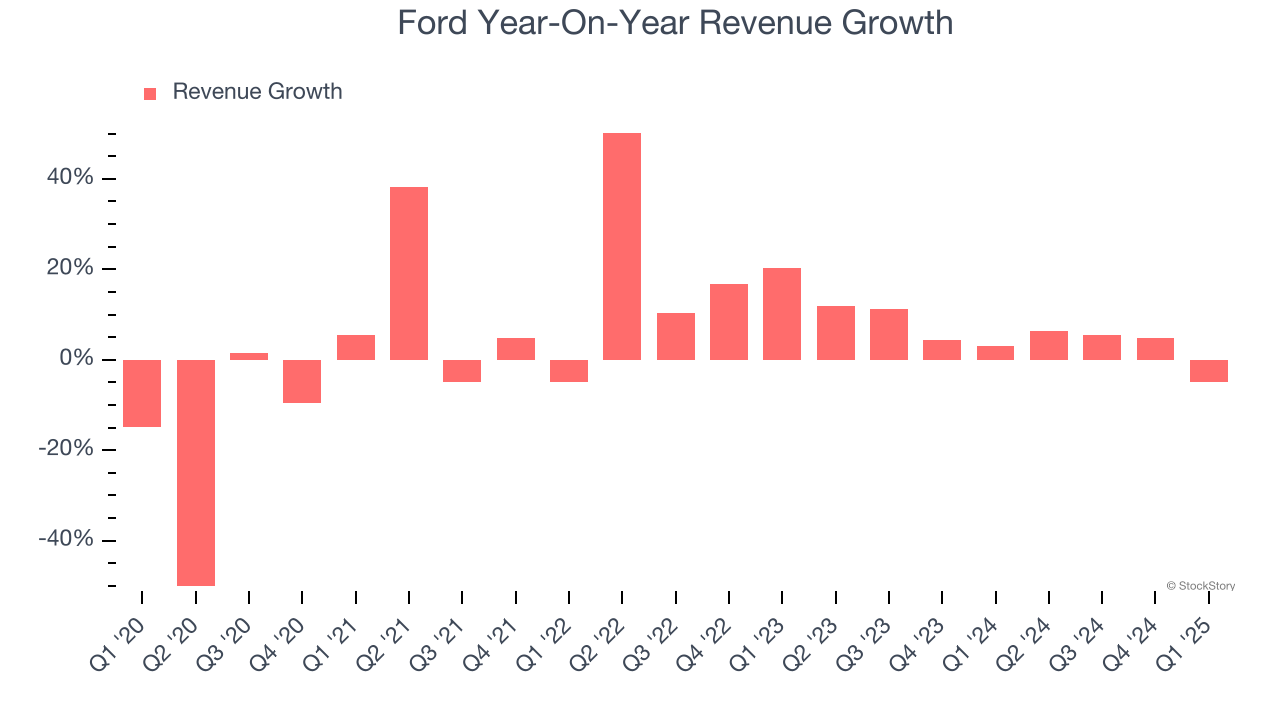
We can dig further into the company’s revenue dynamics by analyzing its number of vehicles sold, which reached 971,000 in the latest quarter. Over the last two years, Ford’s vehicles sold were flat. Because this number is lower than its revenue growth, we can see the company benefited from price increases. 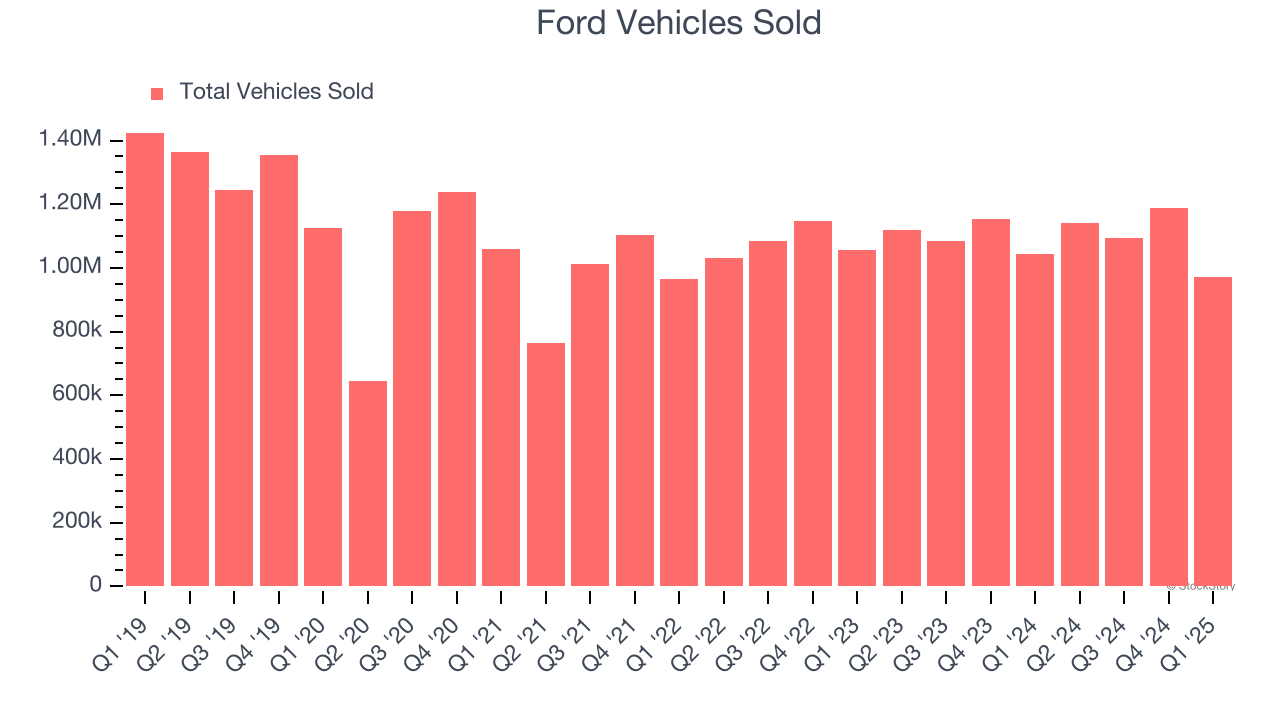
This quarter, Ford’s revenue fell by 5% year on year to $40.66 billion but beat Wall Street’s estimates by 5.6%.
Looking ahead, sell-side analysts expect revenue to decline by 2.9% over the next 12 months, a deceleration versus the last two years. This projection doesn't excite us and indicates its products and services will see some demand headwinds.
Software is eating the world and there is virtually no industry left that has been untouched by it. That drives increasing demand for tools helping software developers do their jobs, whether it be monitoring critical cloud infrastructure, integrating audio and video functionality, or ensuring smooth content streaming. Click here to access a free report on our 3 favorite stocks to play this generational megatrend.
Operating Margin
Operating margin is one of the best measures of profitability because it tells us how much money a company takes home after procuring and manufacturing its products, marketing and selling those products, and most importantly, keeping them relevant through research and development.
Ford was profitable over the last five years but held back by its large cost base. Its average operating margin of 2.4% was weak for an industrials business. This result isn’t too surprising given its low gross margin as a starting point.
On the plus side, Ford’s operating margin rose by 2.7 percentage points over the last five years, as its sales growth gave it operating leverage.
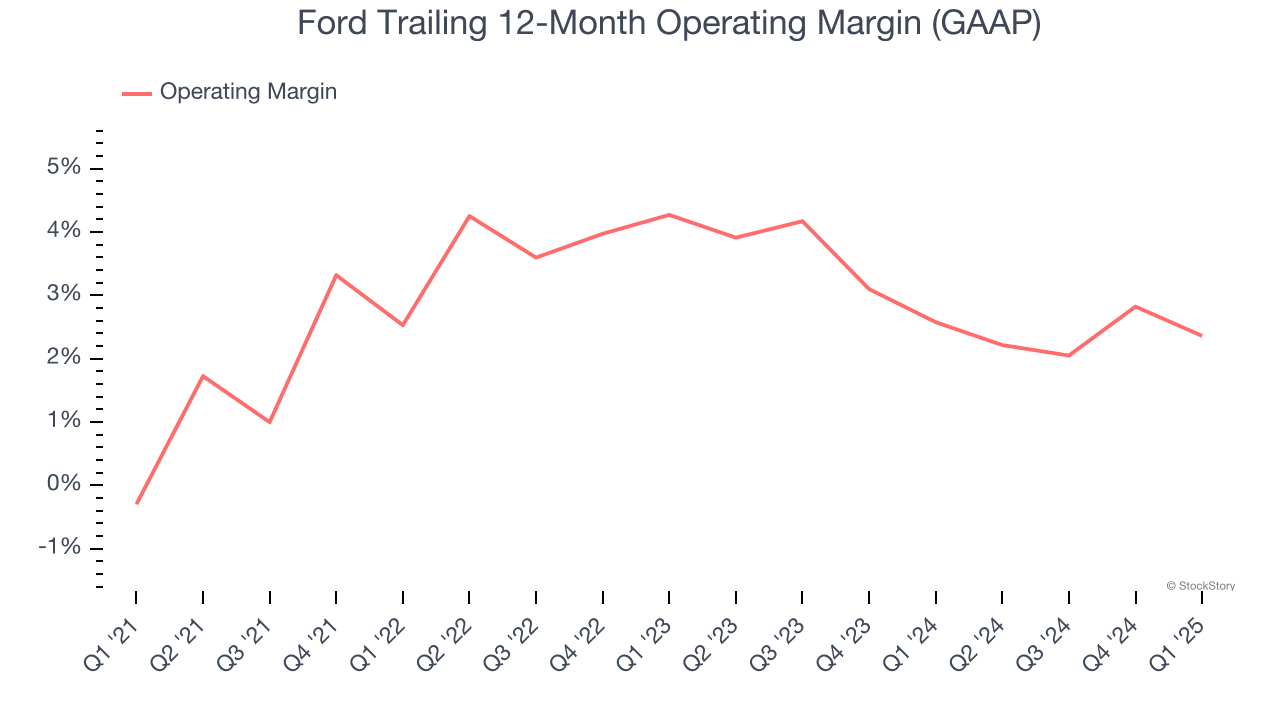
In Q1, Ford’s breakeven margin was down 2.1 percentage points year on year. Conversely, its gross margin actually rose, so we can assume its recent inefficiencies were driven by increased operating expenses like marketing, R&D, and administrative overhead.
Earnings Per Share
We track the long-term change in earnings per share (EPS) for the same reason as long-term revenue growth. Compared to revenue, however, EPS highlights whether a company’s growth is profitable.
Ford’s EPS grew at an astounding 23.7% compounded annual growth rate over the last five years, higher than its 4.1% annualized revenue growth. This tells us the company became more profitable on a per-share basis as it expanded.
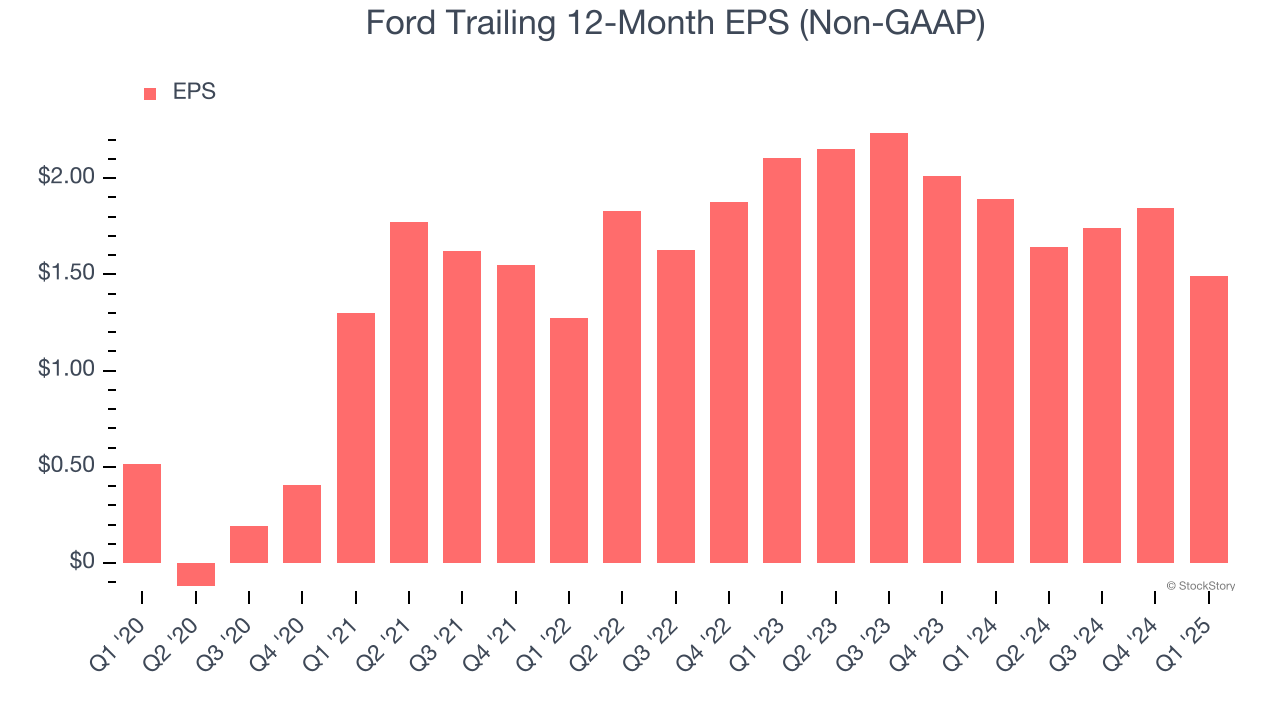
We can take a deeper look into Ford’s earnings quality to better understand the drivers of its performance. As we mentioned earlier, Ford’s operating margin declined this quarter but expanded by 2.7 percentage points over the last five years. This was the most relevant factor (aside from the revenue impact) behind its higher earnings; taxes and interest expenses can also affect EPS but don’t tell us as much about a company’s fundamentals.
Like with revenue, we analyze EPS over a shorter period to see if we are missing a change in the business.
For Ford, its two-year annual EPS declines of 15.9% mark a reversal from its (seemingly) healthy five-year trend. We hope Ford can return to earnings growth in the future.
In Q1, Ford reported EPS at $0.14, down from $0.49 in the same quarter last year. Despite falling year on year, this print easily cleared analysts’ estimates. Over the next 12 months, Wall Street expects Ford’s full-year EPS of $1.49 to shrink by 4.5%.
Key Takeaways from Ford’s Q1 Results
We liked that Ford beat analysts’ revenue and EPS expectations this quarter. However, the company spoke about a $1.5 billion headwind from tariffs on the operating income line and suspended full-year guidance. As a result of these challenges and increased uncertainty, shares traded down 3.1% to $9.88 immediately following the results.
Is Ford an attractive investment opportunity at the current price? We think that the latest quarter is only one piece of the longer-term business quality puzzle. Quality, when combined with valuation, can help determine if the stock is a buy. We cover that in our actionable full research report which you can read here, it’s free.


